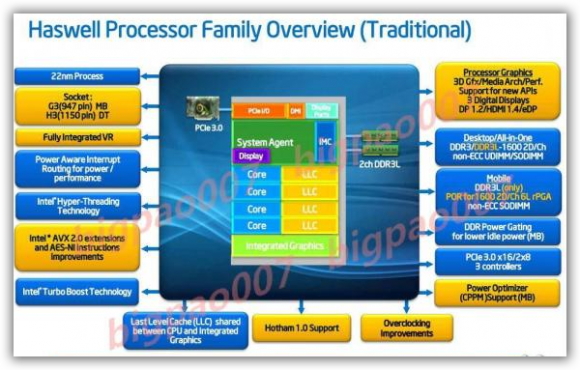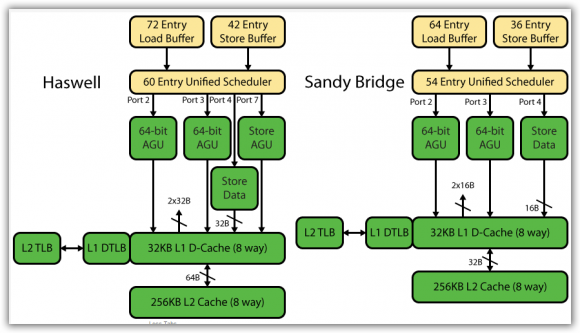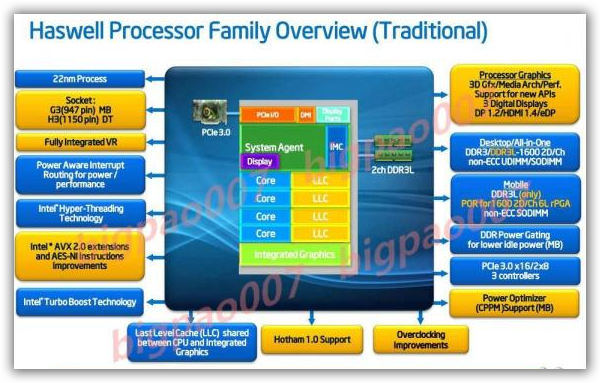aNewDomian.net — It’s the worst-kept secret in Silicon Valley. ( The best kept one was PRISM, but that’s another story.) The poorly-kept secret is about a chip family Intel is code naming Haswell. Intel has talked about Haswell at developers conferences over the last year, but this week Intel officially announced the Haswell family of chips and provided specs on this new 22nm chip tech family. This announcement came at Computex 2012 in Taiwan this week.
Intel claims Haswell mobile and desktop versions will excel at video playback, graphics performance, battery life preservation and will feature a standby mode with fresh data for 10 to 13 days. It’s the mobile version that we’re most interested in, though. Intel is clearly targeting Ultrabooks and Windows 8 systems with this revision, which goes above and beyond its predecessor, the Ivy Bridge transistor technology. And Windows 8 systems sorely need that.
Earlier this year, Intel CPU architects Bret Toll and Robert Chappell told the IT Enquirer that Haswell family chips will feature increased cache size and bandwidth, better branch prediction, two fused multiply-add — that is, FMA — units and a new MOVBE instruction for Endian conversion.
Though it’ll be similar in process mode to what the Ivy Bridge line of processors offer, Intel said there are big changes at the transistor level. Chappell said:
We have done a lot of work with our manufacturing (partners) in order (to) get into these lower power envelopes. So we can tune the process for higher performance or lower power. (But) don’t have the mindset that because it is 22nm it is the same as Ivy Bridge. The process is evolving constantly, especially if we’re targeting different products.”
Chappell added that, “We want to be feature consistent with what we have in Ivy Bridge. By going to the lower process node, we get a higher transistor budget now within the same area and power envelope I can get the same transistors. How I want to use that transistor budget, you look at things like doing the two FMA, that’s clearly something where we benefit from the lower transistor size, as an example.”
It’ll also feature specs that go above and beyond what Ivy Bridge family chips offer, Intel said. Here’s a slide Intel showed detailing the chips planned for the Haswell processor family:

Image Source: Intel
The Haswell chip family will offer twice the FLOPs of the Sandy Bridge family, according to this graphic. Here’s how its structure works to do that — you see from the image how this conceivably will improve the speed of graphics rendering.

Image source: Intel
In true, old-fashioned Wintel style, the mobile version of the chip squarely aims at Ultrabooks — and Microsoft Windows 8 systems, too, which definitely need the boost battery life- and graphics-wise.
Intel says initial Haswell releases will focus on the mobile market. The holy grail, at least so far as Windows 8 mobile devices are concerned, is improved graphics performance, better cache for more performance overall and, especially, for battery life preservation. It’ll improve battery performance on Windows 8 devices dramatically, Intel execs claimed, and initial independent benchmarks are encouraging on this score.
Engadget testing confirmed Intel’s 50 percent improvement in battery life, which doesn’t sound like a lot until you think about it. Considering that Intel also preserves power when the device the chip powers is in sleep mode, that means battery life could as much as double overall.
So the Windows 8-powered Acer Aspire One that I’m testing now, which regularly provides five to six hours of battery life at best, would instead give me eight hours of power, the specs says.
That’s just short of the nine hours I get from my tablet — impressive. It’ll be intriguing to test mobile Windows 8 devices with this technology when they arrive.
So when will we see Haswell devices emerge? Acer is one of several Microsoft Windows 8 partner manufacturers planning more devices around Haswell. Acer plans a 11.6-inch Windows 8 tablet featuring the new chip, probably by the end of the year, Asian sources confirm. Expect more Windows 8 devices featuring Intel Haswell tech to come.
Just when you thought the Wintel alliance was dead …
For aNewDomain.net, I’m Dino Londis.
My colleague at aNewDomain.net, ed director Gina Smith, contributed to this story.
Based in New York, Dino Londis is a senior commentator at aNewDomain.net. He’s also an IT Pro alum at National Lampoon and teamBYTE. Email him at Dino@aNewDomain.net.














Dino,
About how long till we see a lot of Haswell-based products for sale? You gave one example as being available at the end of the year, but won’t there be a lot of others before that?
I thought it was around Q2 of 2014 for release myself.
-RAP, II
[…] included a wider range of Airport Extremes, some with 2TB and 3TB drives. MacBook Airs will be getting the Intel Haswell processor that unleashed recently, an improvement that promises to bring customers up to a full day of battery […]